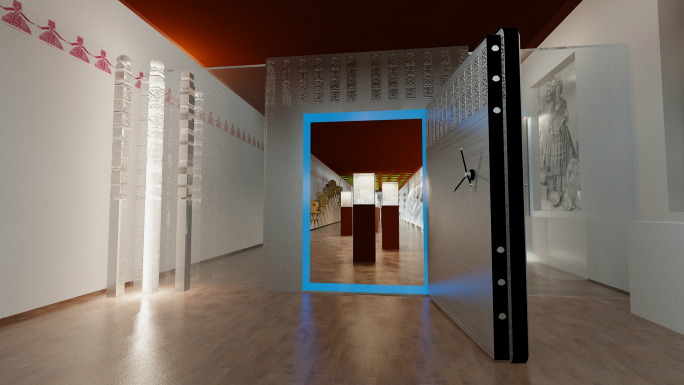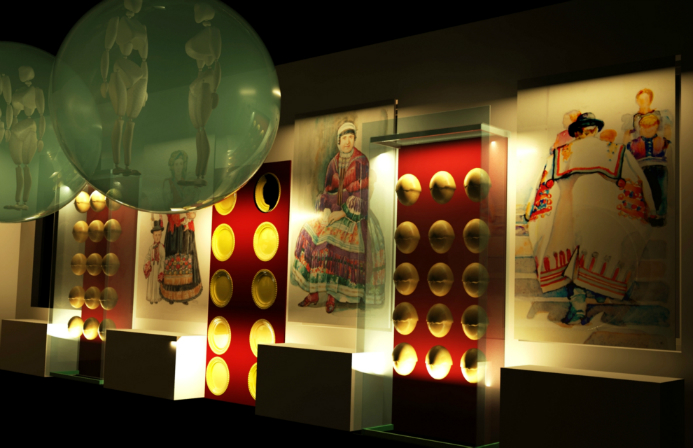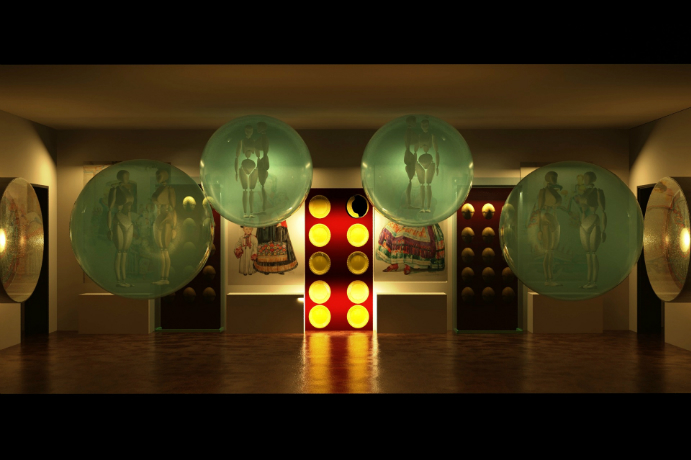The Déri Saga in Debrecen, Chapter 2
ETHNO-VAULT
The Ethno-vault exhibition in Debrecen’s Déri Museum is, by all means, a novelty in the history of ethnographic exhibitions. Anna Keszeg has set out to analyse it.
| Keszeg Anna |
2014-10-21 17:31 |
The foundation of the Déri Museum in Debrecen came down to the ambitions of the entrepreneurial and military elite. The founder, Frigyes Déri, and the donator of the ethnographic collection, György Déri, both invested their wealth in valuable objects. This seems to have had something to do with the fact that neither had offspring, therefore, they might have seen collecting art as a kind of guarantee for the family’s future. Both Frigyes, the silk manufacturer, and György, the colonel, were born in Baja and raised in Vienna. Their career building as well as their cultural horizon was influenced by the Austro-Hungarian Empire. Unfortunately their lives were not well documented and the origin of their passion for art collection is unclear.

It is hard to know why Frigyes collected antique, Far-Eastern, numismatic, and fine art pieces and why György opted for folk art objects. Did they agree on a strategy as to who collected what? Was there the same motivation in both men and did they bring it from their childhood through their socialisation? Did they bring the urge from Vienna? As far as György is concerned, he is known to have started to collect Transylvanian Saxon objects when he was stationed in Nagyszeben, however, it is not clear what earlier experiences, arguments and patterns had shaped his interest. It is also rather obscure why finally Frigyes decided to pass his collection down to Debrecen and not to his native Baja. Why did the desire for a museum in Debrecen, with the help of some lobbying local potentates, proved stronger than the local patriotism felt for his native town?
The context of the collector and the collection
One of the greatest strength of this exhibition is that it places the ethnographic collection of the Déri Museum into the context of the collector and the collection (curator: Márta Magyari, co-curators: Beatrix Kiss és Márta Szászfalvi). The ethnographic collection was donated to the museum by the colonel in 1939 and a group of museologists were assigned to its systematisation. Gábor Lükő was the one who finally carried out this job with tremendous ethnographic rigour, first of all, by setting out for an ethnographic journey to complete the fairly selective collection. The first exhibition opened in 1941 and was disassembled for security reasons before the end of the II. World War, and since then the full collection has not been on display. Now the Ethno-vault exhibition comprises approximately 20 % of the entire collection.

The vault concept
The metaphor in the title is the key to the selection principles and to the exhibition design too. The curator did not follow Gábor Lükő when she selected the items, but decided that the collection had to be shown as a somewhat whimsical hobby of a high rank military officer with bourgeois roots. The visual design at the entrance - the bourgeois china-cabinet interior and the vault elements - reinforces this concept. Welcome to Colonel Déri’s safe. This concept seems to be the only viable contextualization of this collection. The curator was well aware that the thematic groups in Déri’s collection only partly overlapped with those of the ethnographic museums, therefore complementary secondary acquisitions should have been made. However, exhibitions which are arranged around the collector’s ambitions have been gaining ground and becoming an independent paradigm. The Pinacothèque museum in Paris, which only has temporary exhibitions, has hosted several exhibitions which were based on a single collector’s concept. The vault concept, however, is not everywhere as strong as it is at the entrance, and at the end of the exhibition where the links between folk costumes and the 20th century fashion design is highlighted, it turns out that the back of the safe is missing.

Ethnographical Kunstkammer
The exhibition is characterised by a certain degree of eclecticism. In fact the concept and the spectacle are organized by the ideas of the Kunstkammer and the series as well as of the show-case and the dummy. György Déri’s Kunstkammer reflects a more structured and scientific interest than that of the original 16-17th century form of the Kunstkammer, however, due to its aesthetic selection, it is a type of ethnographical Kunstkammer where reconstructing the interior and the objects’ original context is not possible. On the other hand, there are beautiful series, chairs, plates, wine pots, which could provide an environment for each other. Offering a slightly ironic perspective, the first room of the vault features such series which help to understand the idea of folkish culture which is supposed to improve one’s aesthetic understanding. A line of chairs climbing up the wall, the wine pots also placed on the wall, and the plates on the ceiling. Some of the show-cases contain items with the same motifs or with the same function while in the smaller show-cases there is only a single object which, for one reason or another, seems to bear a lot of importance. The logic is that of the safe: value amassed and some great treasures distinguished, but this special extra value can only be understood from the collector’s perspective. The competing paradigms of the Kunstkammer and the series make it possible to understand the logic of amateur collection around the turn of the 20th century.
Textiles with strong visual metaphors
In the hall with the traditional costumes, dummies appear and the headbands are placed on trimmed wooden heads. The dummies with spectacular garments are in huge transparent bubbles, which hang from the ceiling. Skirts are in flat show-cases attached to the side walls. The exhibition design uses two strong metaphors here: the 360° full spectrum view where the symbolic meaning of the object is dominant, and the bubble which suggests isolation, protection and static, motionless pictures. These elements fit in the Déri concept perfectly. The curator quotes Déri himself having said in a discussion of the first exhibition that emphasis had to be put on clothing as foreign tourists were most eager to see the traditional Matyó costumes because they had seen them in films. Déri also wanted dummies which bore the facial features of the people whose clothes the dummies wore, and the plan was to create an elegant and spacious exhibition setting. Contemporary museology today, in many respects, endorses this approach: spectacle and entertainment emphasised, other media universes are lifted in the context of the museum.

Aesthetic restructuring
The last room offers a re-interpretation of folk costumes through the works of contemporary designers: Márta Göbölyös, Margit Madarász Kathy, Éva Mészáros, Szilvia Pálffy. This room is the least compatible with Déri’s original ideas since the logic of aesthetic restructuring is far from his original conservationist concept. The relations between folk costumes, design and fashion could be the topic of an independent exhibition and the Déri Museum in Debrecen is the very place that could host such an event as a tribute to Klára Tüdős Zsindelyné, the great costume designer, and ethnographer who was a native of this town.